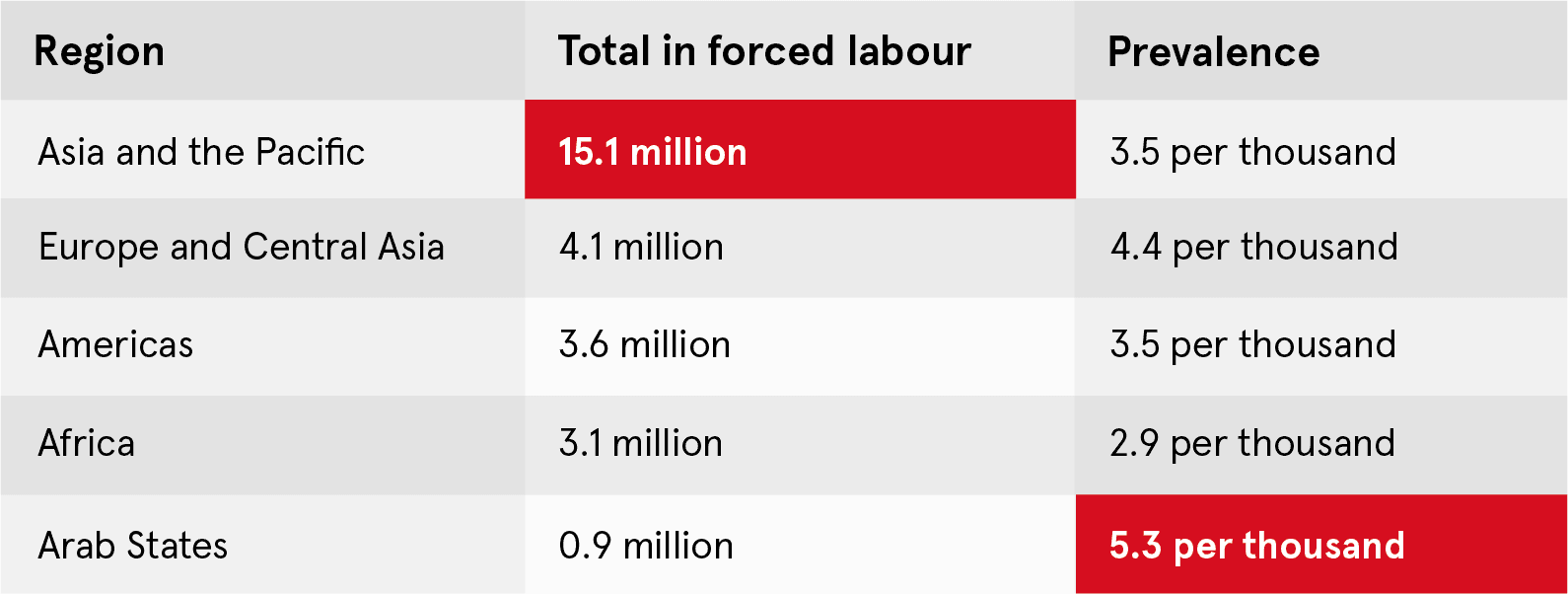ILO releases latest Global Estimates of Modern Slavery
The International Organization for Labor (ILO) and the International Organization for Migration (IOM), together with Walk Free, have released the latest Global Estimates of Modern Slavery. In 2016, it had been estimated that 40.3 million people around the world were trapped in modern-day slavery. Tragically, the latest figures suggest that that has risen to 49.6 million people, or 1 in every 150 people in the world. Of these:
22 million are in forced marriages
This is an increase of 6.6 million since 2016 (i.e. two thirds of the overall increase of c.10 million people in modern-day slavery) though it is likely to be an underestimate as it does not include all child marriages.
27.6 million are in forced labour (an increase of 2.7 million since 2016), including:
- 3.9 million in state-imposed forced labour (e.g. the abuse of compulsory prison labour, conscription, and forced labour for economic development)
- 6.3 million in forced commercial sexual exploitation – nearly 4 out of every 5 are women and girls.
Why has the number increased?
A number of crises are compounding to increase the vulnerability of millions of people to trafficking and exploitation. Armed conflict, climate change, and Covid-19 have led to increases in extreme poverty (with severe effects on national economies and household finances and indebtedness), unsafe migration, and disruptions to employment and education. All of these are risk factors for the different forms of modern slavery, especially as they typically impact those who are already vulnerable, including people in poverty, in irregular employment, and/or without legal protection and rights.
Who is being caught in modern-day slavery?
As in 2016, women and children are disproportionately represented among those caught in modern slavery. Women make up nearly 27 million of all those living in modern slavery, and more than 12 million are children.
- 11.8 million of those in forced labour are women and girls
- Over 2/3 of those in forced marriage are female – 14.9 million women and girls
- 3.3 million victims of forced labour are children – over half of these are trapped in commercial sexual exploitation
Migrant workers are also especially vulnerable to labour exploitation – they are more than three times more likely to be in forced labour than non-migrant adult workers.
Where is modern-day slavery happening?
The latest Global Estimates, published on 12th September 2022, show no country is immune to modern-day slavery. More than half (52%) of all forced labour and 26% of all forced marriages can be found in upper-middle income or high-income countries.

Although two-thirds (65%) of the total number of forced marriages are found in Asia and the Pacific, the prevalence is highest in the Arab States, with 4.8 people out of every 1,000 in the region in forced marriage.
What are these figures based on?
The Global Estimates are based on data from multiple sources:
- Nationally representative household surveys – across 68 countries for forced labour and 75 countries for forced marriage – conducted by the ILO and Walk Free.
- The Counter Trafficking Data Collaborative (CTDC) anonymised case dataset on victims of trafficking collected by IOM and its partners in the process of providing services to trafficked persons.
- For more detail, see the annex of the full report.
This “Eyes on Trafficking” story is reprinted from its original online location.
 ABOUT PBJ LEARNING
ABOUT PBJ LEARNING
PBJ Learning is a leading provider of online human trafficking training, focusing on awareness and prevention education. Their interactive Human Trafficking Essentials online course is used worldwide to educate professionals and individuals how to recognize human trafficking and how to respond to potential victims. Learn on any web browser (even your mobile phone) at any time.
More stories like this can be found in your PBJ Learning Knowledge Vault.
EYES ON TRAFFICKING
This “Eyes on Trafficking” story is reprinted from its original online location.
ABOUT PBJ LEARNING
PBJ Learning is a leading provider of online human trafficking training, focusing on awareness and prevention education. Their interactive Human Trafficking Essentials online course is used worldwide to educate professionals and individuals how to recognize human trafficking and how to respond to potential victims. Learn on any web browser (even your mobile phone) at any time.
More stories like this can be found in your PBJ Learning Knowledge Vault.
